Multi-Scenario Simulating the Effects of Land Use Change on Ecosystem Health for Rural Ecological Management in the Zheng–Bian–Luo Rural Area, Central China
Abstract
:1. Introduction
2. Materials and Methods
2.1. Study Area
2.2. Data Sources and Processing
2.3. Studying Route
2.4. Ecosystem Health Assessment
2.5. Ecosystem Health Simulation Under Multiple Scenarios
2.5.1. The PLUS Model
2.5.2. Accuracy Verification
2.5.3. Simulation of Ecosystem Health Under Multiple Scenarios
3. Results
3.1. Land Use Changes in Zheng–Bian–Luo Rural Area
3.1.1. Land Use Area Changes
3.1.2. Dynamic Characteristics of Land Use
3.1.3. Land Use Transition Characteristics
3.2. Spatiotemporal Changes in Ecosystem Health in Zheng–Bian–Luo Rural Area
3.2.1. Ecosystem Vigor, Organization, Resilience, and Services
3.2.2. Spatiotemporal Dynamics of Ecosystem Health
3.3. Simulation of Ecosystem Health Under Multiple Scenarios in Zheng–Bian–Luo Rural Area
3.3.1. Multi-Scenario Land Use Simulation Analysis
3.3.2. Ecosystem Health Prediction Under Multiple Scenarios
4. Discussion
4.1. Spatiotemporal Changes in Rural Ecosystem Health
4.2. Simulation of Rural Ecosystem Health
4.3. Policy Recommendations
- (1)
- Health Improvement Zone: This zone includes villages with poor and relatively poor levels of ecosystem health near the urban areas of Zhengzhou, Kaifeng, and Luoyang. The government should scientifically plan ecological restoration areas, implement key restoration projects, and encourage and support public and societal participation. Measures should include the efficient utilization of resources to reduce development intensity, greening activities in ecologically degraded villages, and alleviation of ecosystem pressure.
- (2)
- Health Optimization Zone: This zone comprises villages with average levels of health in the plains areas of Zhengzhou, Kaifeng, and Luoyang, particularly between the mountainous and urban areas of Luoyang, between Songshan and Zhengzhou, and in most areas surrounding the outskirts of Kaifeng. Villages in these areas can focus on developing circular agriculture, promoting advanced ecological protection technologies, and planning land use patterns in a reasonable manner. Moreover, smart management levels should be enhanced, information transparency should be improved, and the regulatory system for ecosystem health should be strengthened. Additionally, cross-regional cooperation between Zhengzhou, Kaifeng, and Luoyang can be fostered to achieve better scientific management and improve ecosystem integrity and continuity.
- (3)
- Health Conservation Zone: This zone includes areas with high levels of health, such as the southwest mountainous regions of Luoyang, northern Xin’an County, and villages near Songshan. These areas are ecologically sensitive, and attention should be given to adjacent cultivated lands. To enhance supervision, it is crucial to improve and integrate policies and regulations for ecosystem health with digital technologies. Achieving a balance between tourism and ecological protection, as well as establishing appropriate ecological compensation mechanisms, are of utmost importance.
4.4. Methodological Limitations
5. Conclusions
- (1)
- From 2000 to 2020, the area of cultivated land in Zheng–Bian–Luo rural areas decreased, the area of forest land first decreased and then increased, and the area of construction land increased.
- (2)
- During the study period, ecosystem health improved as ecosystem vigor and services increased. From 2000 to 2020, low-value areas of ecosystem health showed a shrinking trend, most notably in Kaifeng.
- (3)
- The PLUS model yielded a Kappa coefficient of 0.777 and an FoM coefficient of 0.122, suggesting its suitability for simulating the 2035 land use status. The ND scenario shows the most significant expansion of construction land and the largest reduction in grassland. Cultivated land decreases under the ND and EP scenarios but increases under the CP scenario, reaching a size 1.14 times that of 2020.
- (4)
- The simulated average ecosystem health values for the ND, EP, and CP scenarios are 0.34, 0.37, and 0.35, respectively, in 2035. In comparison to 2020, no areas are identified as having poor ecosystem health levels, with the EP scenario exhibiting the best ecosystem health for the Zheng–Bian–Luo rural area in 2035. The ecosystem health near the Songshan Mountains, which was at an excellent level in 2020, experienced a significant decline under the ND and CP scenarios. However, when compared to the EP scenario, the CP scenario demonstrates advantages in improving the ecosystem health of the western rural areas of Luoyang and the southeastern agricultural areas of Kaifeng.
Author Contributions
Funding
Data Availability Statement
Conflicts of Interest
References
- Manggat, I.; Zain, R.; Jamaluddin, Z. The Impact of Infrastructure Development on Rural Communities: A Literature Review. Int. J. Acad. Res. Bus. Soc. Sci. 2018, 8, 637–648. [Google Scholar] [CrossRef] [PubMed]
- Wang, Y.; Zhao, N.; Lei, X.; Long, R. Green Finance Innovation and Regional Green Development. Sustainability 2021, 13, 8230. [Google Scholar] [CrossRef]
- Ahn, S.R.; Kim, S.J. Assessment of integrated watershed health based on the natural environment, hydrology, water quality, and aquatic ecology. Hydrol. Earth Syst. Sci. 2017, 21, 5583–5602. [Google Scholar] [CrossRef]
- Allen, E. Forest Health Assessment in Canada. Ecosyst. Health 2001, 7, 28–34. [Google Scholar] [CrossRef]
- Rapport, D.J. What constitutes ecosystem health? Perspect. Biol. Med. 1989, 33, 120–132. [Google Scholar] [CrossRef]
- Schaeffer, D.J.; Herricks, E.E.; Kerster, H.W. Ecosystem health: I. Measuring ecosystem health. Environ. Manag. 1988, 12, 445–455. [Google Scholar] [CrossRef]
- Costanza, R. Toward an Operational Definition of Ecosystem Health. In Ecosystem Health: New Goals for Environmental Management; Island Press: Washington, DC, USA, 1992; pp. 239–269. [Google Scholar]
- Fu, B.J.; Liu, S.L.; Ma, K.M. The contents and methods of integrated ecosystem assessment (IEA). Acta Ecol. Sin. 2001, 21, 1885–1892. [Google Scholar]
- Xiao, F.; Ouyang, H. Ecosystem Health and Its Evolution Indicator and Method. J. Nat. Resour. 2002, 2, 203–209. [Google Scholar]
- Cui, B.S.; Yang, Z.F. Research review on wetland ecosystem health. China J. Ecol. 2001, 20, 31–36. [Google Scholar]
- Sun, Y.; Zhou, Y.M.; Zhang, Q.W. Ecosystem Health: Theory, Concept and Assessment Methods. Adv. Earth Sci. 2011, 26, 887–896. [Google Scholar]
- Huo, Z.; Wang, J. Assessment on Ecological Health in Northwest Conservation Area of Beijing City Based on PSR Model. China Land Sci. 2020, 34, 105–112. [Google Scholar]
- Zhou, Q.; Peng, C.; Liu, X.; Xiang, Y.; Zhou, L. Ecosystem health assessment of water level fluctuating zone in three gorges reservoir area based on VOR model. Res. Soil Water Conserv. 2022, 29, 310–318. [Google Scholar]
- Chen, W.X.; Zhao, X.L.; Zhong, M.X.; Li, J.F.; Zeng, J. Spatiotemporal evolution patterns of ecosystem health in the Middle Reaches of the Yangtze River Urban Agglomerations. Acta Ecol. Sin. 2022, 42, 138–149. [Google Scholar]
- Bi, X.; Fu, Y.; Wang, P.; Zhang, Y.; Yang, Z.; Hou, F.; Li, B. Ecosystem health assessment based on deep learning in a mountain-basin system in Central Asia’s arid regions, China. Ecol. Indic. 2024, 165, 112148. [Google Scholar] [CrossRef]
- Xu, W.; He, M.; Meng, W.; Zhang, Y.; Yun, H.; Lu, Y.; Huang, Z.; Mo, X.; Hu, B.; Liu, B.; et al. Temporal-spatial change of China’s coastal ecosystems health and driving factors analysis. Sci. Total Environ. 2022, 845, 157319. [Google Scholar] [CrossRef]
- Ye, D.; Yang, L.; Zhou, M. Spatiotemporal Variation in Ecosystem Health and Its Driving Factors in Guizhou Province. Land 2023, 12, 1439. [Google Scholar] [CrossRef]
- Yuan, M.; Liu, Y.; Wang, M.; Tian, L.; Peng, J. Ecosystem health assessment based on the framework of vigor, organization, resilience and contribution in Guangzhou City. Chin. J. Ecol. 2019, 38, 1249–1257. [Google Scholar]
- Li, Y.; Deng, M.; Fang, G.; Lu, Y.; Sun, C.; Zhu, Z. Ecosystem health evaluation based on land use change—Case study of the riparian zone of the Yangtze River in Jiangsu Province, China. Environ. Monit. Assess. 2024, 196, 206. [Google Scholar] [CrossRef]
- Wu, W.; Hu, J.; Song, D. Assessment of marine ecosystem health and its key influencing factors in Laizhou Bay, China. Front. Mar. Sci. 2023, 10, 1115896. [Google Scholar] [CrossRef]
- Wei, H.; Han, Q.; Yang, Y.; Li, L.; Liu, M. Spatial Heterogeneity of Watershed Ecosystem Health and Identification of Its Influencing Factors in a Mountain–Hill–Plain Region, Henan Province, China. Remote Sens. 2023, 15, 3751. [Google Scholar] [CrossRef]
- Chen, W. A multi-scale assessment of ecosystem health based on the Pressure-State-Response framework: A case in the Middle Reaches of the Yangtze River Urban Agglomerations, China. Environ. Sci. Pollut. Res. 2022, 29, 29202–29219. [Google Scholar] [CrossRef]
- Shen, W.; Li, Y.; Qin, Y. Research on the influencing factors and multi-scale regulatory pathway of ecosystem health: A case study in the Middle Reaches of the Yellow River, China. J. Clean. Prod. 2023, 406, 137038. [Google Scholar] [CrossRef]
- Yang, L.; Chen, W.; Pan, S.; Zeng, J.; Yuan, Y.; Gu, T. Spatial relationship between land urbanization and ecosystem health in the Yangtze River Basin, China. Environ. Monit. Assess. 2023, 195, 957. [Google Scholar] [CrossRef]
- Wu, S.; Tian, C.; Li, B.; Wang, J.; Wang, Z. Ecological environment health assessment of lake water ecosystem system based on simulated annealing-projection pursuit: A case study of plateau lake. Sustain. Cities Soc. 2022, 86, 104131. [Google Scholar] [CrossRef]
- Guo, Y.; Xu, D.; Xu, J.; Yang, Z. Multi-Scale Analysis of Spatial and Temporal Evolution of Ecosystem Health in the Harbin–Changchun Urban Agglomeration, China. Sustainability 2024, 16, 837. [Google Scholar] [CrossRef]
- Qiao, W.; Huang, X. The impact of land urbanization on ecosystem health in the Yangtze River Delta urban agglomerations, China. Cities 2022, 130, 103981. [Google Scholar] [CrossRef]
- Ashraf, A.; Haroon, M.A.; Ahmad, S.; Abowarda, A.S.; Wei, C.Y.; Liu, X.H. Use of remote sensing-based pressure-state-response framework for the spatial ecosystem health assessment in Langfang, China. Environ. Sci. Pollut. Res. 2023, 30, 89395–89414. [Google Scholar] [CrossRef]
- Hasani, S.S.; Mojtahedi, A.; Reshadi, M.A.M. Development of a novel fuzzy logic-based wetland health assessment approach for the management of freshwater wetland ecosystems. Wetlands 2021, 41, 100. [Google Scholar] [CrossRef]
- Wu, C.; Chen, W. Indicator system construction and health assessment of wetland ecosystem-Taking Hongze Lake Wetland, China as an example. Ecol. Indic. 2020, 112, 106164. [Google Scholar] [CrossRef]
- Das, S.; Pradhan, B.; Shit, P.K.; Alamri, A.M. Assessment of Wetland Ecosystem Health Using the Pressure–State–Response (PSR) Model: A Case Study of Mursidabad District of West Bengal (India). Sustainability 2020, 12, 5932. [Google Scholar] [CrossRef]
- Zhao, H.; Wang, G.; Song, Y.; Zhao, Q. Evaluation of ecosystem health in Futian mangrove wetland based on the PSR-AHP model. Appl. Math. Nonlinear Sci. 2022, 7, 985–998. [Google Scholar] [CrossRef]
- Bai, X.L.; Wang, L.X.; Ji, S.X.; Chen, Z.X.; Chang, X.L. Assessment of ecosystem health in grassland-desert ecotone in northern Ordos: A case study of Ten Tributaries Basin. J. Desert Res. 2020, 40, 187–194. [Google Scholar]
- Soubry, I.; Doan, T.; Chu, T.; Guo, X. A Systematic Review on the Integration of Remote Sensing and GIS to Forest and Grassland Ecosystem Health Attributes, Indicators, and Measures. Remote Sens. 2021, 13, 3262. [Google Scholar] [CrossRef]
- Wang, K.; Cao, C.; Xie, B.; Xu, M.; Yang, X.; Guo, H.; Duerler, R.S. Analysis of the Spatial and Temporal Evolution Patterns of Grassland Health and Its Driving Factors in Xilingol. Remote Sens. 2022, 14, 5179. [Google Scholar] [CrossRef]
- Wu, Z.; Lei, S.; Lu, Q.; Bian, Z.; Ge, S. Spatial distribution of the impact of surface mining on the landscape ecological health of semi-arid grasslands. Ecol. Indic. 2020, 111, 105996. [Google Scholar] [CrossRef]
- Zhou, Y.; Yue, D.; Li, S.; Liang, G.; Chao, Z.; Zhao, Y.; Meng, X. Ecosystem health assessment in debris flow-prone areas: A case study of Bailong River Basin in China. J. Clean. Prod. 2022, 357, 131887. [Google Scholar] [CrossRef]
- Li, H.; Wan, H.; Sun, L.; Liu, Y.; Li, L.; Wang, Y. Remote sensing assessment and key driving factors of ecosystem health in Xinjiang. Arid Land Geogr. 2021, 44, 460–470. [Google Scholar]
- Yao, Y.; Li, S.; Su, M.; Liao, L.; Xu, C.; Yue, W. County ecosystem health assessment: A case study of 32 counties in Dongguan City, China. Acta Ecol. Sin. 2021, 41, 5998–6011. [Google Scholar]
- Das, M.; Inácio, M.; Das, A.; Barcelo, D.; Pereira, P. Mapping and Assessment of Ecosystem Health in the Vilnius Functional Zone (Lithuania). Sci. Total Environ. 2024, 912, 168891. [Google Scholar] [CrossRef]
- Brisbois, M.C.; Jamieson, R.; Gordon, R.; Stratton, G.; Madani, A. Stream ecosystem health in rural mixed land-use watersheds. J. Environ. Eng. Sci. 2008, 7, 439–452. [Google Scholar] [CrossRef]
- Connell, D.J. Sustainable Livelihoods and Ecosystem Health: Exploring Methodological Relations as a Source of Synergy. EcoHealth 2010, 7, 351–360. [Google Scholar] [CrossRef]
- Javaid, M.; Shafi, A.; Hamid, A.; Jehangir, A.; Yousuf, A. Dynamics of the wetland ecosystem health in urban and rural settings in high altitude ecoregion. Sci. Total Environ. 2023, 904, 166566. [Google Scholar] [CrossRef]
- Xu, Y.; Chen, Q.; Zeng, H. Rural Ecosystem Health Assessment and Spatial Divergence—A Case Study of Rural Areas around Qinling Mountain, Shaanxi Province, China. Sustainability 2024, 16, 6323. [Google Scholar] [CrossRef]
- Xiao, Z.; Liu, R.; Gao, Y.; Yang, Q.; Chen, J. Spatiotemporal variation characteristics of ecosystem health and its driving mechanism in the mountains of southwest China. J. Clean. Prod. 2022, 345, 131138. [Google Scholar] [CrossRef]
- Peng, J.; Liu, Y.; Li, T.; Wu, J. Regional ecosystem health response to rural land use change: A case study in Lijiang City, China. Ecol. Indic. 2017, 72, 399–410. [Google Scholar] [CrossRef]
- Liu, Y.; Yang, C.; Tan, S.; Zhou, H.; Zeng, W. An approach to assess spatio-temporal heterogeneity of rural ecosystem health: A case study in Chongqing mountainous area, China. Ecol. Indic. 2022, 136, 108644. [Google Scholar] [CrossRef]
- Lei, D.; Zhang, Y.; Ran, Y.; Gao, L.; Li, J.; Li, Z.; Mo, J.; Liu, X. Assessment of ecosystem health based on landscape pattern in ecologically fragile regions at different spatial scales: A case study of dianchi lake basin, China. Front. Environ. Sci. 2023, 11, 1076344. [Google Scholar] [CrossRef]
- Liu, Y.; Xu, N.; Zeng, H. Ecosystem health assessment and its scale dependence in the coastal region of the East China Sea. Acta Ecol. Sin. 2022, 42, 9913–9926. [Google Scholar]
- Ren, Y.; Lü, Y.; Comber, A.; Fu, B.; Harris, P.; Wu, L. Spatially explicit simulation of land use/land cover changes: Current coverage and future prospects. Earth-Sci. Rev. 2019, 190, 398–415. [Google Scholar] [CrossRef]
- Yang, S.; Su, H.; Zhao, G. Multi-scenario simulation of urban ecosystem service value based on PLUS model: A case study of Hanzhong city. J. Arid. Land Resour. Environ. 2022, 36, 86–95. [Google Scholar]
- Shi, J.; Shi, P.; Wang, Z.; Wang, L.; Li, Y. Multi-Scenario Simulation and Driving Force Analysis of Ecosystem Service Value in Arid Areas Based on PLUS Model: A Case Study of Jiuquan City, China. Land 2023, 12, 937. [Google Scholar] [CrossRef]
- Lou, Y.; Yang, D.; Zhang, P.; Zhang, Y.; Song, M.; Huang, Y.; Jing, W. Multi-Scenario Simulation of Land Use Changes with Ecosystem Service Value in the Yellow River Basin. Land 2022, 11, 992. [Google Scholar] [CrossRef]
- Wang, B.; Chen, H.; Dong, Z.; Zhu, W.; Qiu, Q.; Tang, L. Impact of land use change on the water conservation service of ecosystems in the urban agglomeration of the Golden Triangle of Southern Fujian, China, in 2030. Acta Ecol. Sin. 2020, 40, 484–498. [Google Scholar]
- Liu, K.; Zhang, C.; Zhang, H.; Xu, H.; Xia, W. Spatiotemporal Variation and Dynamic Simulation of Ecosystem Carbon Storage in the Loess Plateau Based on PLUS and InVEST Models. Land 2023, 12, 1065. [Google Scholar] [CrossRef]
- Li, P.; Chen, J.; Li, Y.; Wu, W. Using the InVEST-PLUS Model to Predict and Analyze the Pattern of Ecosystem Carbon storage in Liaoning Province, China. Remote Sens. 2023, 15, 4050. [Google Scholar] [CrossRef]
- Zhao, H.; Guo, B.; Wang, G. Spatial–Temporal Changes and Prediction of Carbon Storage in the Tibetan Plateau Based on PLUS-InVEST Model. Forests 2023, 14, 1352. [Google Scholar] [CrossRef]
- Zhang, D. Study on the Value of Cultural Ecosystem Service in Rural Area—A Case of Huzhou, Zhejiang Province; Zhejiang University: Hangzhou, China, 2021. [Google Scholar]
- Yan, F.; Shangguan, W.; Zhang, J.; Hu, B. Depth-to-bedrock map of China at a spatial resolution of 100 meters. Sci. Data 2020, 7, 1–13. [Google Scholar] [CrossRef]
- Wu, Y.; Shi, K.; Chen, Z.; Liu, S.; Chang, Z. Developing Improved Time-Series DMSP-OLS-Like Data (1992–2019) in China by Integrating DMSP-OLS and SNPP-VIIRS. IEEE Trans. Geosci. Remote Sens. 2022, 60, 4407714. [Google Scholar] [CrossRef]
- Zhu, W.Q.; Pan, Y.Z.; Zhang, J.S. Estimation of net primary productivity of Chinese terrestrial Vegetation based on remote sensing. J. Plant Ecol. 2007, 31, 413–424. [Google Scholar]
- Han, P.; Hu, H.; Zhou, J.; Wang, M.; Zhou, Z. Integrating key ecosystem services to study the spatio-temporal dynamics and determinants of ecosystem health in Wuhan’s central urban area. Ecol. Indic. 2024, 166, 112352. [Google Scholar] [CrossRef]
- Peng, J.; Liu, Y.; Wu, J.; Lv, H.; Hu, X. Linking Ecosystem Services and Landscape Patterns to Assess Urban Ecosystem Health: A Case Study in Shenzhen City, China. Landsc. Urban Plan. 2015, 143, 56–68. [Google Scholar] [CrossRef]
- Sharp, R.; Douglass, J.; Wolny, S.; Arkema, K.; Bernhardt, J.; Bierbower, W.; Chaumont, N.; Denu, D.; Fisher, D.; Glowinski, K.; et al. InVEST 3.10.2. User’s Guide; The Natural Capital Project; Stanford University: Stanford, CA, USA, 2020. [Google Scholar]
- Meng, Q.; Zhang, L.; Wei, H.; Cai, E.; Xue, D.; Liu, M. Linking Ecosystem Service Supply–Demand Risks and Regional Spatial Management in the Yihe River Basin, Central China. Land 2021, 10, 843. [Google Scholar] [CrossRef]
- Xie, G.; Zhen, L.; Lu, C.-X.; Xiao, Y.; Chen, C. Expert knowledge based valuation method of ecosystem services in China. J. Nat. Resour. 2008, 23, 911–919. (In Chinese) [Google Scholar]
- Zhou, Y.; Li, X.; Liu, Y. Land use change and driving factors in rural China during the period 1995–2015. Land Use Policy 2020, 99, 105048. [Google Scholar] [CrossRef]
- Wang, J.; Chen, Y.; Shao, X.; Zhang, Y.; Cao, Y. Land-use changes and policy dimension driving forces in China: Present, trend and future. Land Use Policy 2012, 29, 737–749. [Google Scholar] [CrossRef]
- Allan, A.; Soltani, A.; Abdi, M.H.; Zarei, M. Driving Forces behind Land Use and Land Cover Change: A Systematic and Bibliometric Review. Land 2022, 11, 1222. [Google Scholar] [CrossRef]
- Liu, J.; Zhang, Z.; Xu, X.; Kuang, W.; Zhou, W.; Zhang, S.; Li, R.; Yan, C.; Yu, D.; Wu, S.; et al. Spatial patterns and driving forces of land use change in China during the early 21st century. J. Geogr. Sci. 2010, 20, 483–494. [Google Scholar] [CrossRef]
- Wang, Z.; Guo, M.; Zhang, D.; Chen, R.; Xi, C.; Yang, H. Coupling the Calibrated GlobalLand30 Data and Modified PLUS Model for Multi-Scenario Land Use Simulation and Landscape Ecological Risk Assessment. Remote Sens. 2023, 15, 5186. [Google Scholar] [CrossRef]
- Zhou, Y.; Geng, J.; Liu, X. Urban Habitat Quality Enhancement and Optimization under Ecological Network Constraints. Land 2024, 13, 1640. [Google Scholar] [CrossRef]
- Hua, Z.; Ma, J.; Sun, Y.; Yang, Y.; Zhu, X.; Chen, F. Multi-Scenario Simulating the Impacts of Land Use Changes on Ecosystem Health in Urban Agglomerations on the Northern Slope of the Tianshan Mountain, China. Land 2024, 13, 571. [Google Scholar] [CrossRef]
- Zhang, J.; Ding, H.; Xu, J.; Zheng, B. A Simulation-Based Prediction of Land Use Change Impacts on Carbon Storage from a Regional Imbalance Perspective: A Case Study of Hunan Province, China. Land 2024, 13, 1721. [Google Scholar] [CrossRef]
- State Bureau of Surveying and Mapping. Rules for Grading Agricultural Land [TD/T 1005-2003]; China Standards Publishing House: Beijing, China, 2003. [Google Scholar]
- Dong, G.; Ge, Y.; Jia, H.; Sun, C.; Pan, S. Land Use Multi-Suitability, Land Resource Scarcity and Diversity of Human Needs: A New Framework for Land Use Conflict Identification. Land 2021, 10, 1003. [Google Scholar] [CrossRef]
- Liang, X.; Guan, Q.; Clarke, K.C.; Liu, S.; Wang, B.; Yao, Y. Understanding the drivers of sustainable land expansion using a patch-generating land use simulation (PLUS) model: A case study in Wuhan, China. Comput. Environ. Urban Syst. 2021, 85, 101569. [Google Scholar] [CrossRef]
- Li, W.; Kang, J.; Wang, Y. Identifying the contribution and spatial effects of land use conversion on ecosystem health in Chongqing: A multi-scenario simulation perspective. Ecol. Indic. 2024, 165, 112232. [Google Scholar] [CrossRef]
- Song, W.; Deng, X.Z. Land-use/land-cover change and ecosystem service provision in China. Sci. Total Environ. 2016, 576, 705–719. [Google Scholar] [CrossRef]
- Mallick, J.; Al Qadhi, S.; Talukdar, S.; Pradhan, B.; Bindajam, A.A.; Islam, A.R.M.T.; Dajam, A.S. A Novel Technique for Modeling Ecosystem Health Condition: A Case Study in Saudi Arabia. Remote Sens. 2021, 13, 2632. [Google Scholar] [CrossRef]
- Chen, W.; Gu, T.; Xiang, J.; Luo, T.; Zeng, J.; Yuan, Y. Ecological restoration zoning of territorial space in China: An ecosystem health perspective. J. Environ. Manag. 2024, 364, 121371. [Google Scholar] [CrossRef]
- Wang, X.; Yao, W.; Luo, Q.; Yun, J. Spatial relationship between ecosystem health and urbanization in coastal mountain city, Qingdao, China. Ecol. Inform. 2024, 79, 102458. [Google Scholar] [CrossRef]
- Liu, R.; Dong, X.; Wang, X.; Zhang, P.; Liu, M.; Zhang, Y. Relationship and driving factors between urbanization and natural ecosystem health in China. Ecol. Indic. 2023, 147, 109972. [Google Scholar] [CrossRef]
- Chen, W.; Wang, G.; Zeng, J. Impact of urbanization on ecosystem health in Chinese urban agglomerations. Environ. Impact Assess. Rev. 2023, 98, 106964. [Google Scholar] [CrossRef]
- Wu, J.; Cheng, D.; Xu, Y.; Huang, Q.; Feng, Z. Spatial-temporal change of ecosystem health across China: Urbanization impact perspective. J. Clean. Prod. 2021, 326, 129393. [Google Scholar] [CrossRef]
- Li, W.; Xie, S.; Wang, Y.; Huang, J.; Cheng, X. Effects of urban expansion on ecosystem health in Southwest China from a multi-perspective analysis. J. Clean. Prod. 2021, 294, 126341. [Google Scholar] [CrossRef]
- Das, M.; Das, A.; Pereira, P.; Mandal, A. Exploring the Spatio-Temporal Dynamics of Ecosystem Health: A Study on a Rapidly Urbanizing Metropolitan Area of Lower Gangetic Plain, India. Ecol. Indic. 2021, 125, 107584. [Google Scholar] [CrossRef]
- Wei, H.; Xue, D.; Huang, J.; Liu, M.; Li, L. Identification of Coupling Relationship between Ecosystem Services and Urbanization for Supporting Ecological Management: A Case Study on Areas along the Yellow River of Henan Province. Remote Sens. 2022, 14, 2277. [Google Scholar] [CrossRef]

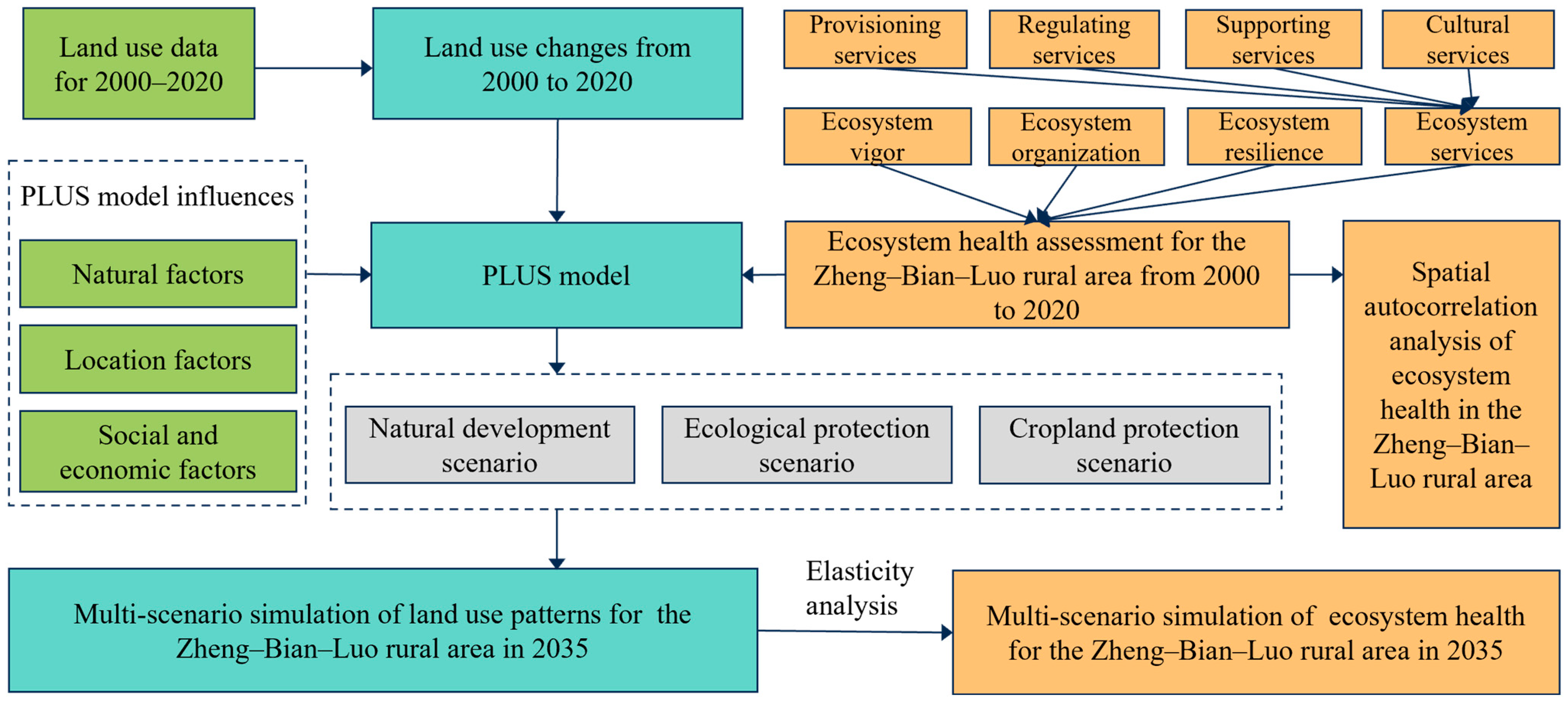
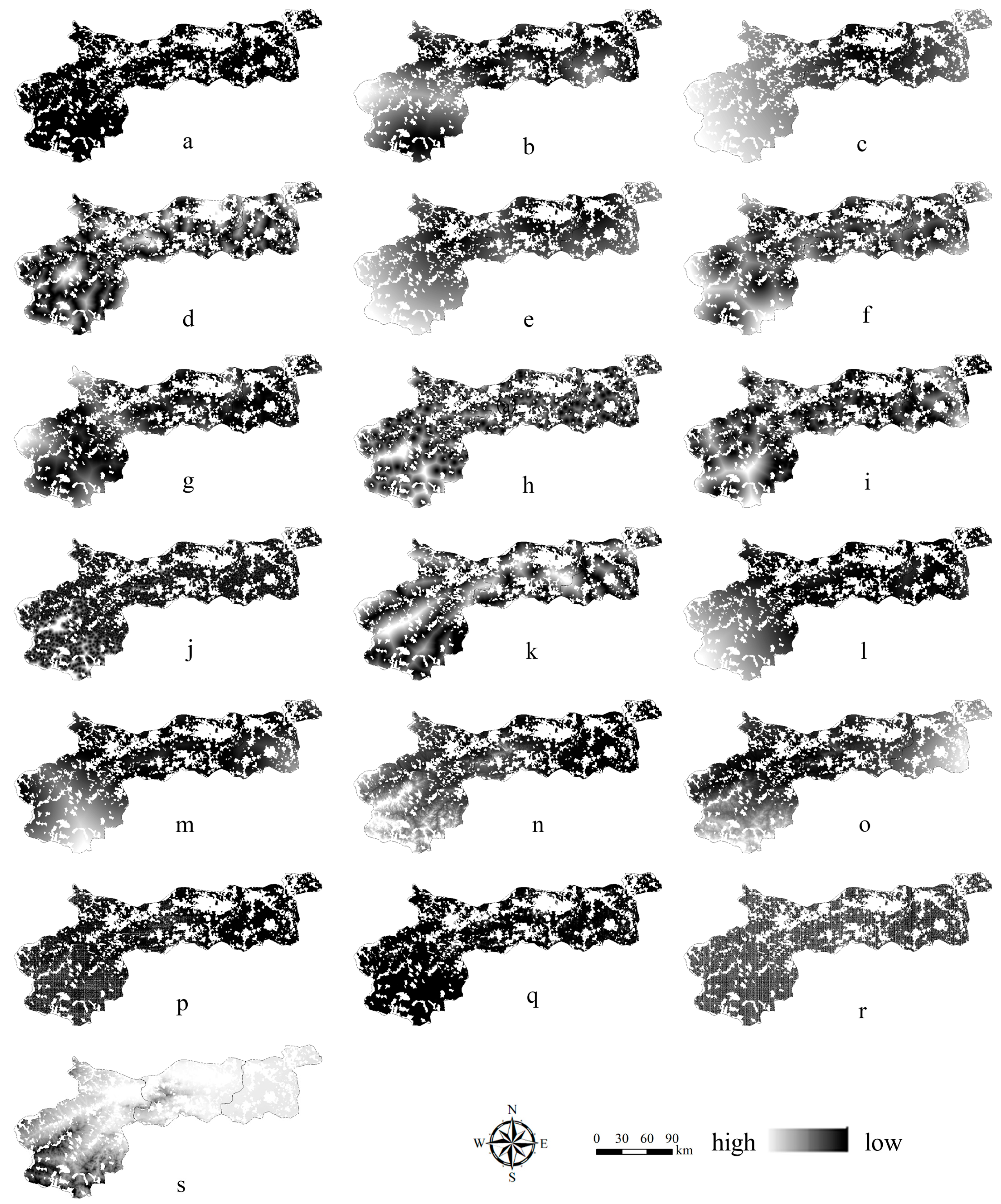

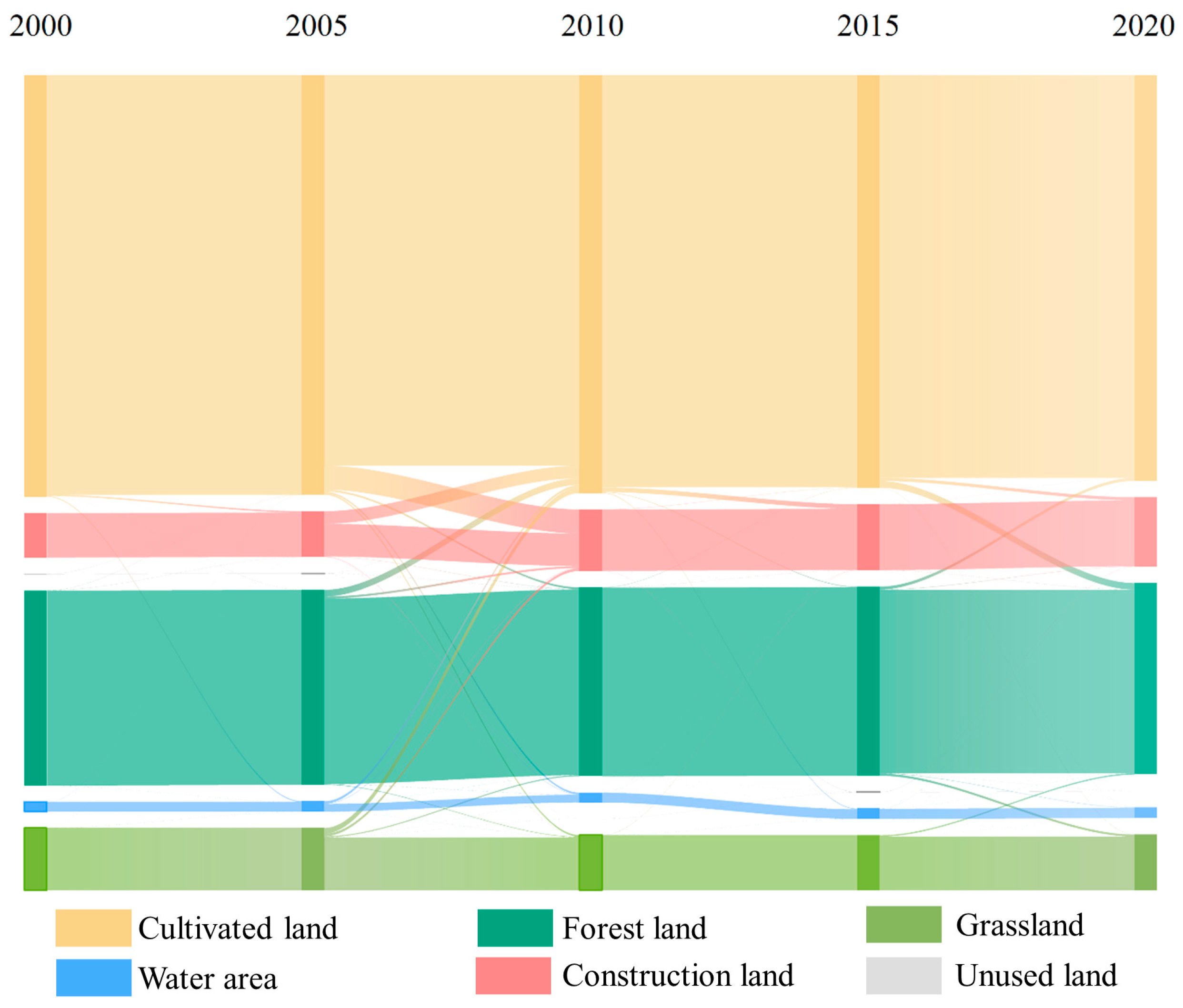
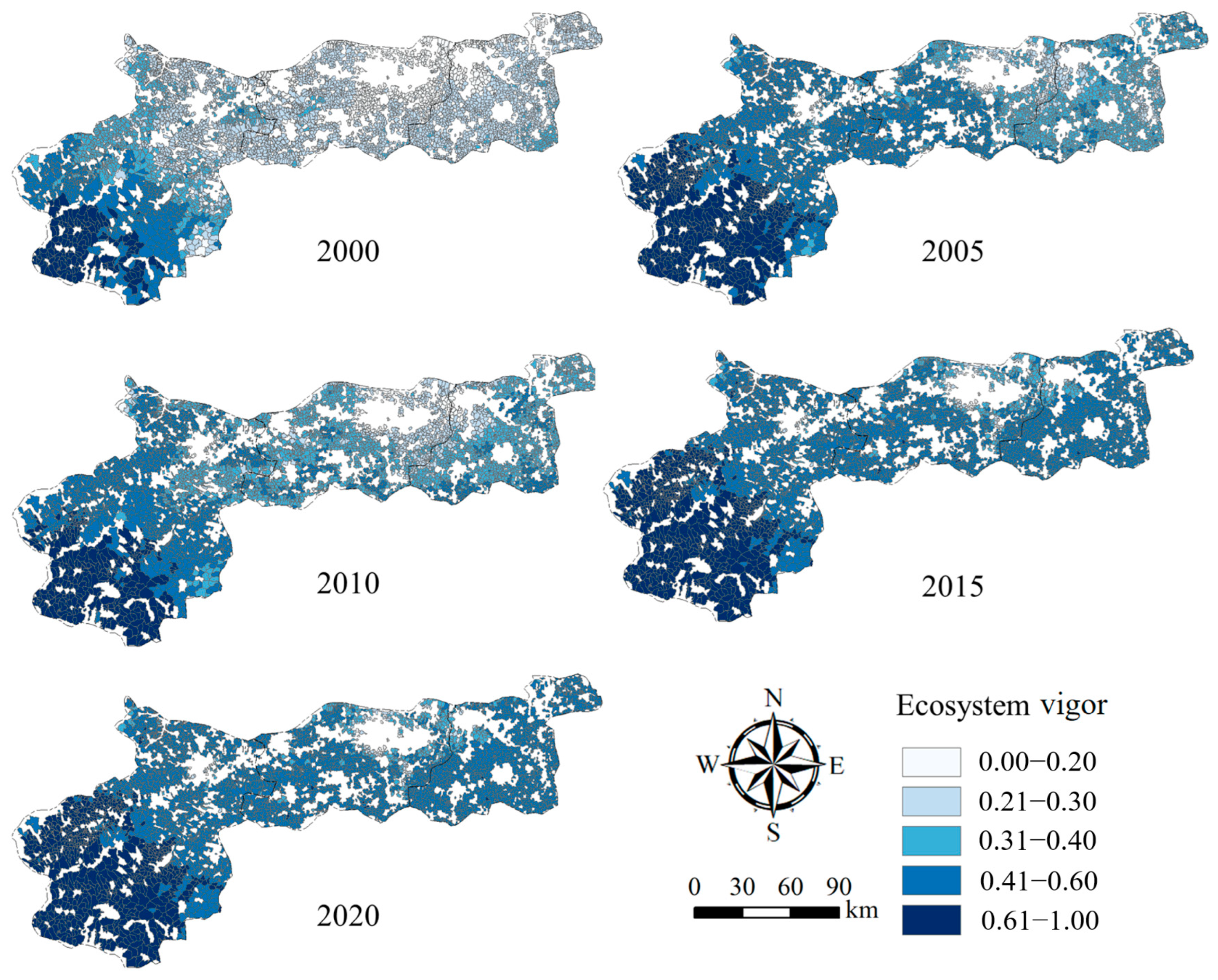


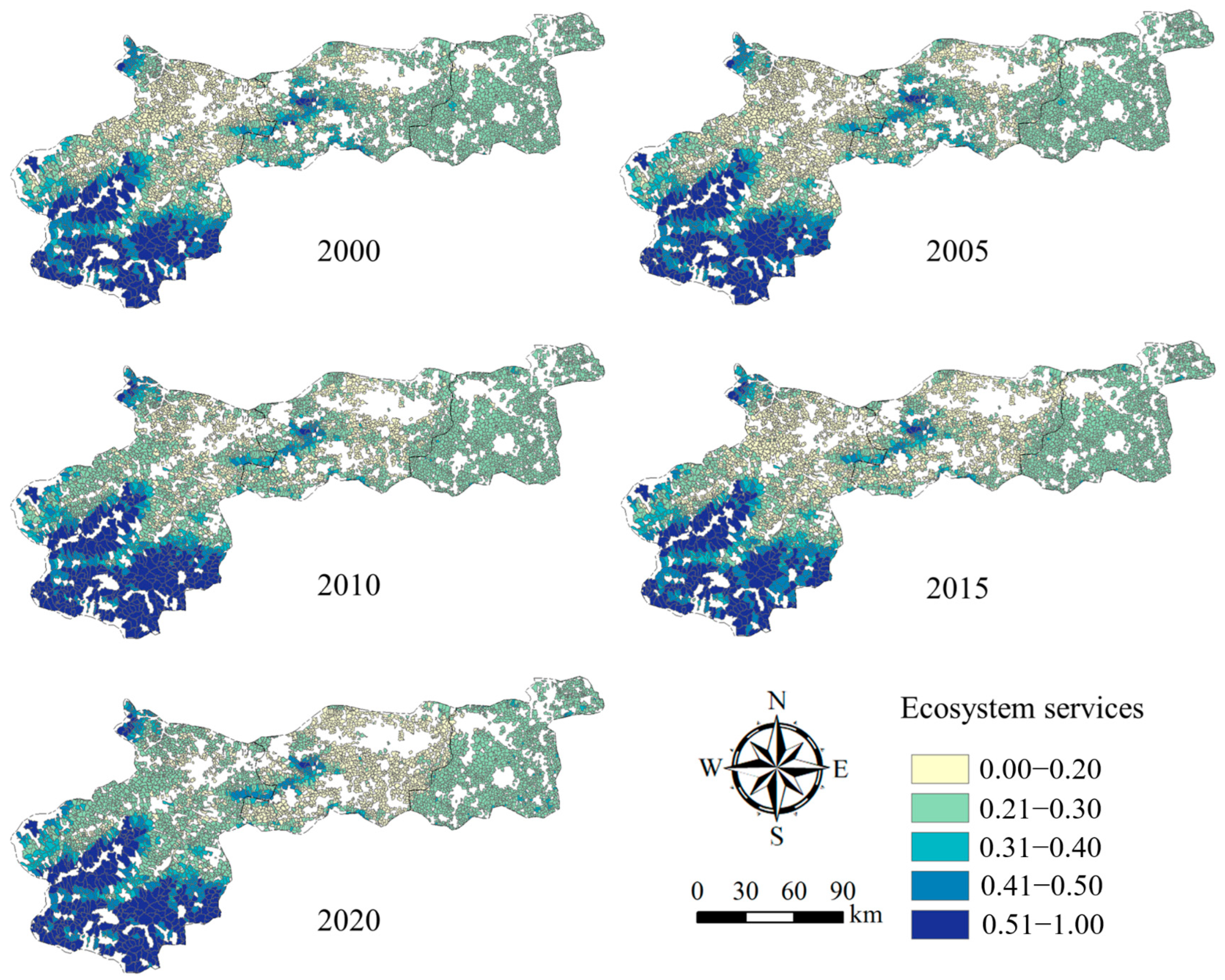
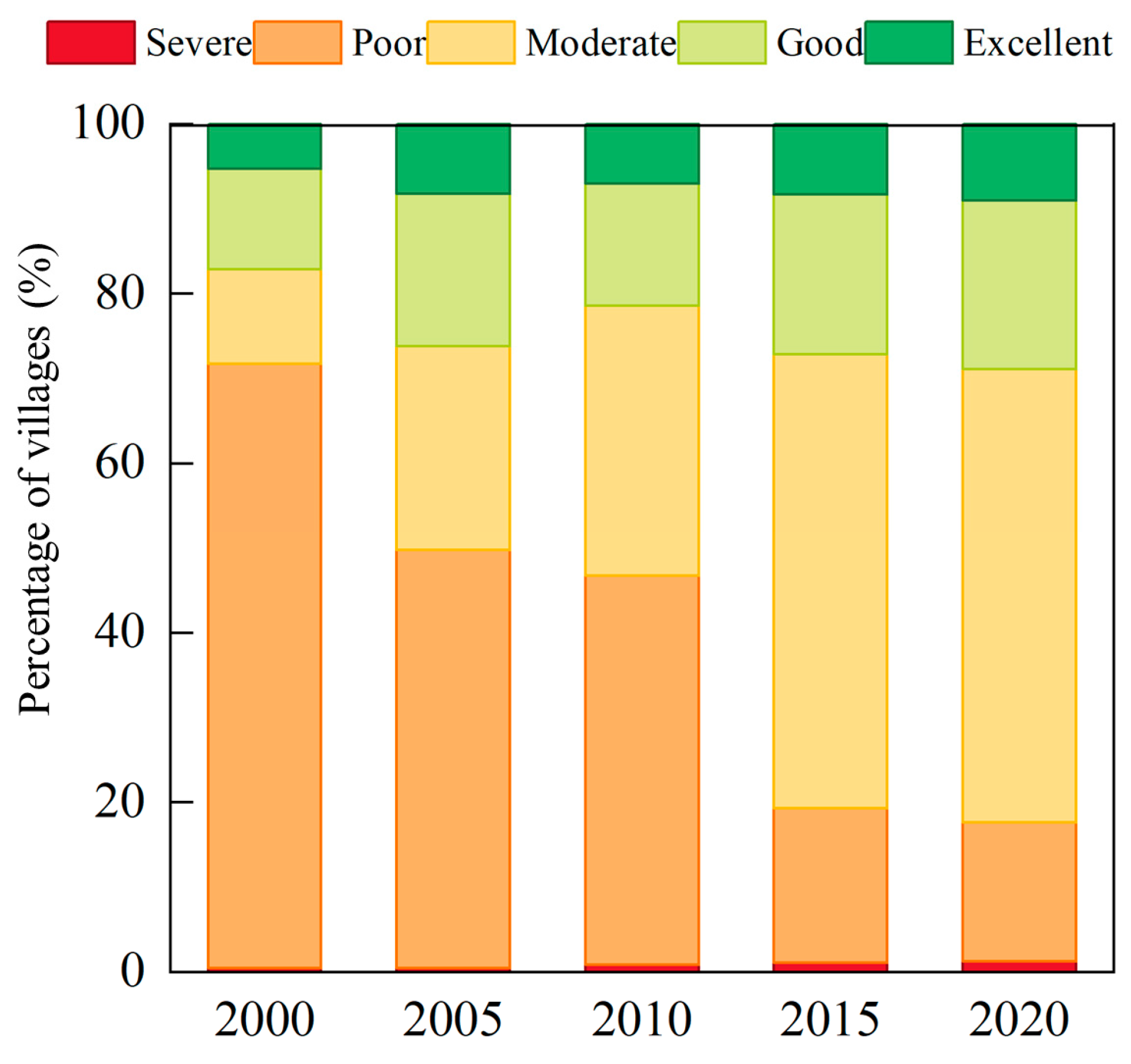
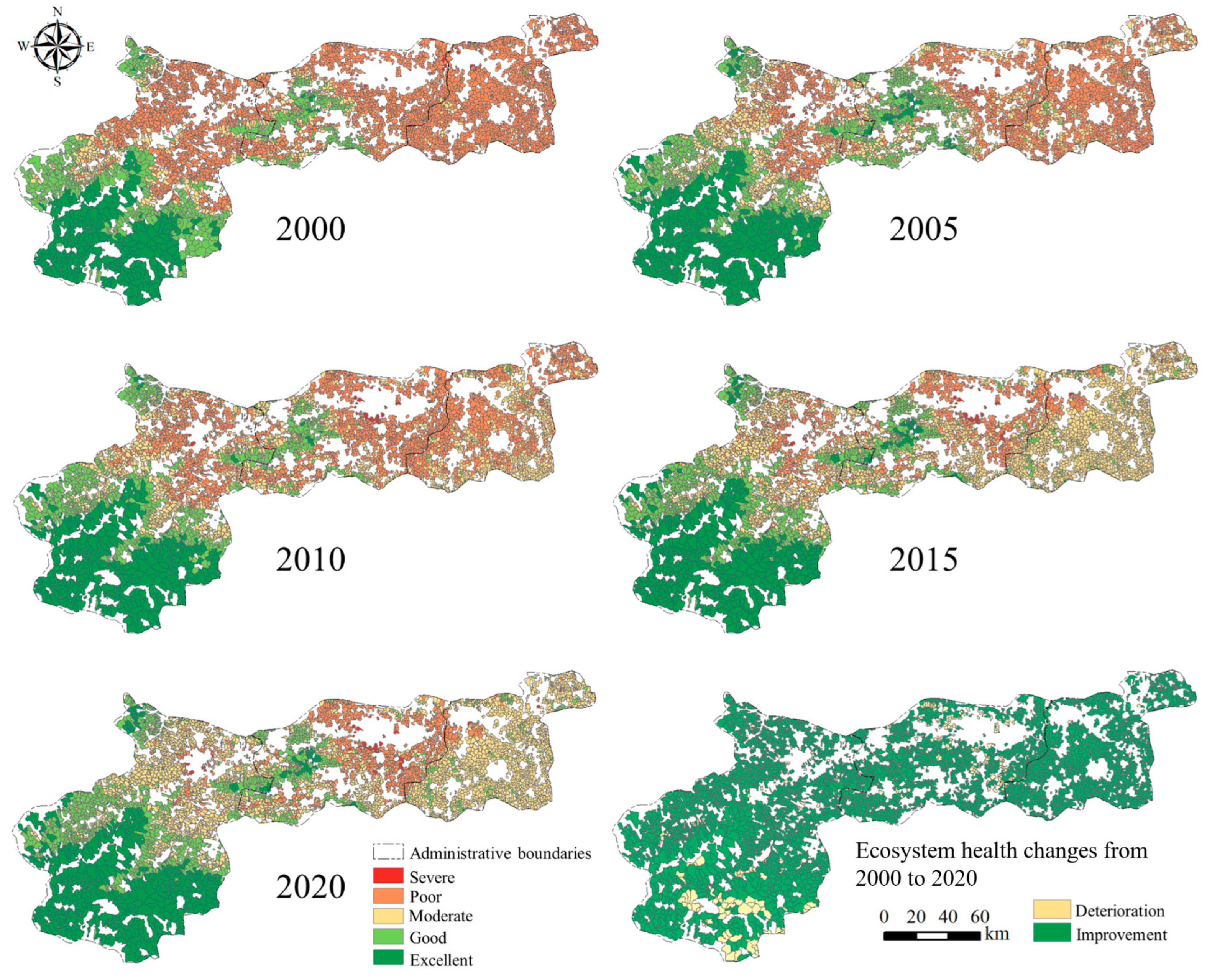
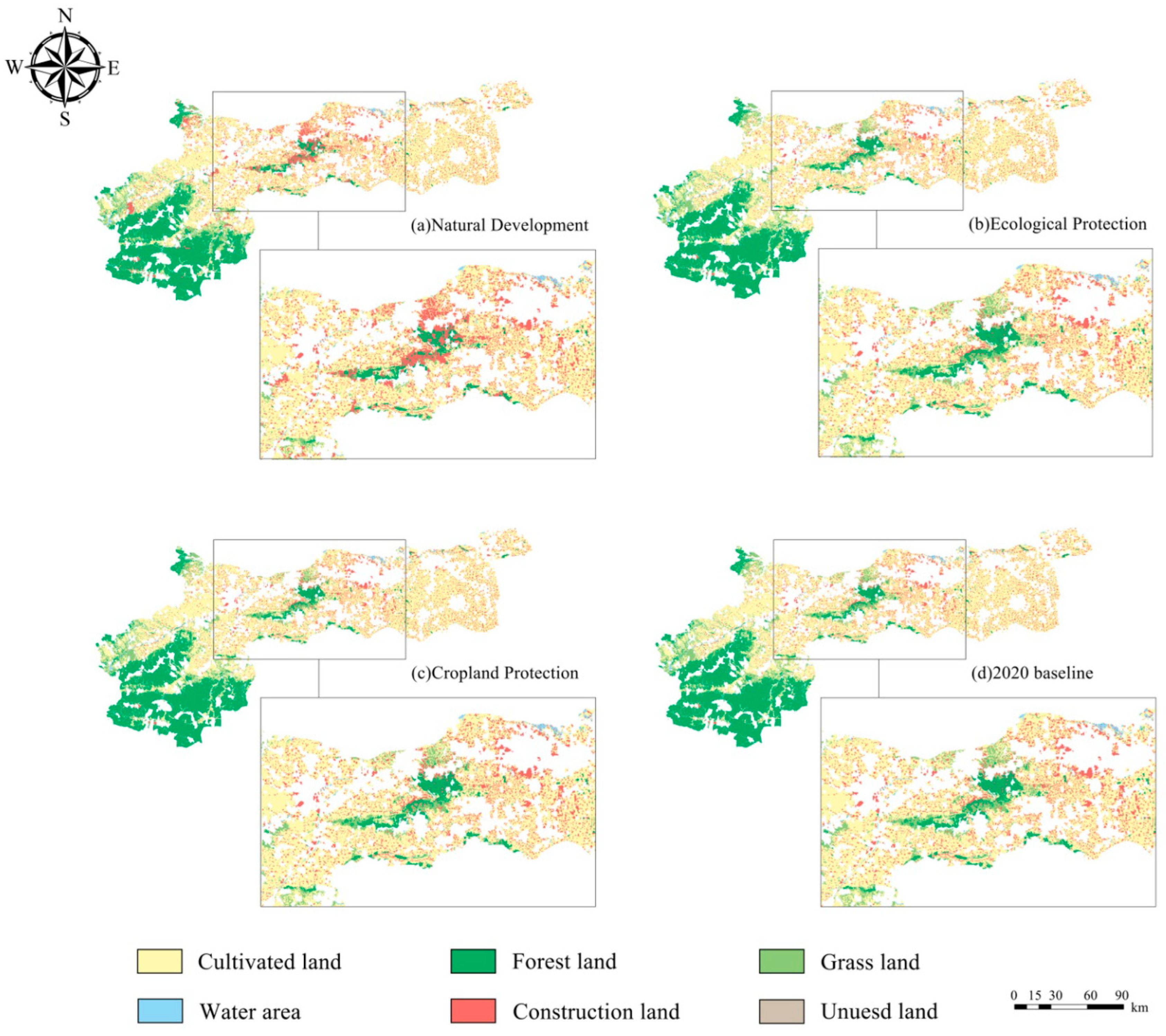


| Data Name | Data Format | Data Source | Data Use |
|---|---|---|---|
| DEM | Raster data | http://www.gscloud.cn/search (accessed on 16 June 2023) | Obtain DEM, extract slope and aspect |
| Land Use Remote Sensing Data | Raster data | http://www.resdc.cn/ (accessed on 8 June 2023) | Basic parameter input for simulating NPP and InVEST model |
| MOD13Q1 | Raster data | NASA website (https://www.nasa.gov/ (accessed on 4 June 2023)) | Obtain NDVI data |
| Global Land Cover Data China Subset | Raster data | Cold and Arid Regions Science Data Center (http://bdc.casnw.net/index.shtml (accessed on 12 September 2023)) | Obtain vegetation-type data for the study area |
| Soil Texture and Soil Organic Matter Content | Raster data | Cold and Arid Regions Science Data Center (http://bdc.casnw.net/index.shtml (accessed on 12 September 2023)) | Basic parameter input for the InVEST model |
| Root Depth Data [59] | Raster data | Sun Yat-sen University Land-Atmosphere Interaction Research Group (http://globalchange.bnu.edu.cn/research (accessed on 15 May 2023)) | Basic parameter input for the InVEST model |
| Temperature, Precipitation, and Potential Evapotranspiration Data | List data | http://data.cma.cn/ (accessed on 19 July 2022) | Input for the InVEST model and PLUS model |
| Food Production, County Population, and Regional GDP | Statistical data | Henan Statistical Yearbook, various county statistical bureaus | Study area overview, food supply |
| Night Light Index [60] | Raster data | An improved time–series DMSP–OLS–like data (1992–2021) in China by integrating DMSP–OLS and SNPP–VIIRS—Harvard Dataverse | Input for the PLUS model |
| GDP, Population Density | Raster data | https://www.resdc.cn/ (accessed on 8 June 2023) | Input for the PLUS model |
| Ecosystem Services | Indicator | Method | Formula Description |
|---|---|---|---|
| Provisioning Services | Food Production | Mapping statistical food production data using the notable linear correlation observed between NDVI and yields of crops and livestock products [21,65]. | Gi is the food supply of grid i, Gsum is the total food production, NDVIi is the NDVI of grid i, and NDVIsum is the sum of NDVI values of cultivated land. |
| Regulating Services | Water Yield | Quantitative calculation of each grid’s water yield based on the water balance principle, utilizing the discrepancy between precipitation and actual evapotranspiration as per the water yield module in the InVEST model [64]. | WY(x) is the water yield of grid x (mm), AEF(x) is the annual actual evapotranspiration of grid x (mm), and P(x) is the annual precipitation of grid x (mm). |
| Carbon Storage | Calculation of carbon storage considering four carbon pools: aboveground, belowground, soil, and dead organic matter according to the InVEST model carbon storage module [64]. | CStotal is the total carbon storage, CSabove is the aboveground biomass carbon storage, CSblow is the belowground biomass carbon storage, CSsoil is the soil carbon storage, and CSdead is the dead organic matter carbon storage. | |
| Water Purification | Calculation of water purification considering the purification of Total Nitrogen and Total Phosphorus according to the InVEST model water purification module [64]. | AIVi is the load value of grid unit i, poli is the output coefficient of grid unit i, and HSSi is the hydrological sensitivity score of grid unit i. | |
| Supporting Services | Soil Retention | Estimated using the Universal Soil Loss Equation (USLE), considering the plot’s ability to intercept upstream sediments [21]. | SC is the soil retention, RKLS and USLE are the potential and actual erosion amounts (t·hm−2·a−1), respectively, R is the rainfall erosivity factor (MJ·mm·hm−2·h−1 a−1), K is the soil erodibility factor (t·hm2·h·MJ−1·mm−1·hm2), LS is the topographic factor, C is the vegetation cover factor, and P is the soil conservation management factor. |
| Habitat Quality | Calculation of habitat quality considering the threat of settlements, farming, roads and population according to the InVEST model water purification module [64]. | Qxj is the habitat quality index of land use/cover type j in grid unit x, Hj is the habitat suitability of land use/cover type j, Dx is the habitat degradation degree of land use/cover type j in grid unit x, k is the half-saturation constant (half of the maximum degradation), and z is the normalization constant (a default parameter in the model). | |
| Cultural Services | Cultural Services | Measured based on the value equivalent method [66] and appropriately adjusted using three crops: wheat, corn, and peanuts. | D is the cultural service value per equivalent factor (CNY/ha), i is the crop type, mi is the planting area of crop i (ha), pi is the national average price of crop i in a certain year (CNY/kg), qi is the unit area yield of crop i (kg/ha), and M is the total planting area of all crops (ha). |
| Scenario Mode | Scenario Description |
|---|---|
| Natural Development (ND) Scenario | Based on the land use expansion rate from 2000 to 2020, without altering the land use conversion probability. |
| Ecological Protection (EP) Scenario | Follows ecological protection principles. Due to data limitations, only natural reserves are set as restricted expansion areas. The conversion probability of forest and grassland to construction land is reduced by 50%, and the reduced land area is added to forest and grassland. The conversion probability from cultivated land to construction land is decreased by 30%, and the conversion probability from forest land to cultivated land is reduced by 50%. The decreased proportions are reallocated to the probability of cultivated land converting to forest land. |
| Cropland Protection (CP) Scenario | Overlays cultivated land data from 2000 to 2020, selecting areas that were consistently cultivated land over five years as long-term stable cultivated land. Additionally, high-quality cultivated land with slopes less than 6° is extracted based on the Agricultural Land Grading Procedures and previous studies [75,76], and these areas are merged as restricted conversion zones. |
| Land Use Type | Actual Situation | Simulated Situation | Error | |||
|---|---|---|---|---|---|---|
| Area (km2) | Proportion (%) | Area (km2) | Proportion (%) | Area (km2) | Proportion (%) | |
| Cropland | 10,729.491 | 55.318 | 10,933.686 | 56.371 | 204.195 | 1.053 |
| Forestland | 5066.152 | 26.120 | 4892.353 | 25.224 | 173.799 | 0.896 |
| Grassland | 1476.877 | 7.614 | 1370.927 | 7.068 | 105.950 | 0.546 |
| Water | 283.186 | 1.460 | 269.708 | 1.391 | 13.478 | 0.069 |
| Construction Land | 1836.361 | 9.468 | 1926.219 | 9.931 | 89.858 | 0.463 |
| Unused land | 3.941 | 0.020 | 3.115 | 0.016 | 0.826 | 0.004 |
| Period | Cropland | Forestland | Grassland | Water | Construction Land | Unused Land |
|---|---|---|---|---|---|---|
| 2000–2005 | −0.09 | −0.02 | −0.02 | 1.81 | 0.66 | −6.34 |
| 2005–2010 | −0.08 | −0.63 | −2.29 | −1.21 | 6.86 | −11.55 |
| 2010–2015 | −0.25 | 0.02 | −0.08 | 1.16 | 1.48 | 40.95 |
| 2015–2020 | −0.34 | 0.27 | 0.33 | 0.45 | 1.01 | −5.02 |
| 2000–2020 | −0.19 | −0.09 | −0.52 | 0.54 | 2.83 | −1.70 |
Disclaimer/Publisher’s Note: The statements, opinions and data contained in all publications are solely those of the individual author(s) and contributor(s) and not of MDPI and/or the editor(s). MDPI and/or the editor(s) disclaim responsibility for any injury to people or property resulting from any ideas, methods, instructions or products referred to in the content. |
© 2024 by the authors. Licensee MDPI, Basel, Switzerland. This article is an open access article distributed under the terms and conditions of the Creative Commons Attribution (CC BY) license (https://creativecommons.org/licenses/by/4.0/).
Share and Cite
Wei, H.; Han, Q.; Ma, Y.; Ji, W.; Fan, W.; Liu, M.; Huang, J.; Li, L. Multi-Scenario Simulating the Effects of Land Use Change on Ecosystem Health for Rural Ecological Management in the Zheng–Bian–Luo Rural Area, Central China. Land 2024, 13, 1788. https://doi.org/10.3390/land13111788
Wei H, Han Q, Ma Y, Ji W, Fan W, Liu M, Huang J, Li L. Multi-Scenario Simulating the Effects of Land Use Change on Ecosystem Health for Rural Ecological Management in the Zheng–Bian–Luo Rural Area, Central China. Land. 2024; 13(11):1788. https://doi.org/10.3390/land13111788
Chicago/Turabian StyleWei, Hejie, Qing Han, Yu Ma, Wenfeng Ji, Weiguo Fan, Mengxue Liu, Junchang Huang, and Ling Li. 2024. "Multi-Scenario Simulating the Effects of Land Use Change on Ecosystem Health for Rural Ecological Management in the Zheng–Bian–Luo Rural Area, Central China" Land 13, no. 11: 1788. https://doi.org/10.3390/land13111788
APA StyleWei, H., Han, Q., Ma, Y., Ji, W., Fan, W., Liu, M., Huang, J., & Li, L. (2024). Multi-Scenario Simulating the Effects of Land Use Change on Ecosystem Health for Rural Ecological Management in the Zheng–Bian–Luo Rural Area, Central China. Land, 13(11), 1788. https://doi.org/10.3390/land13111788







